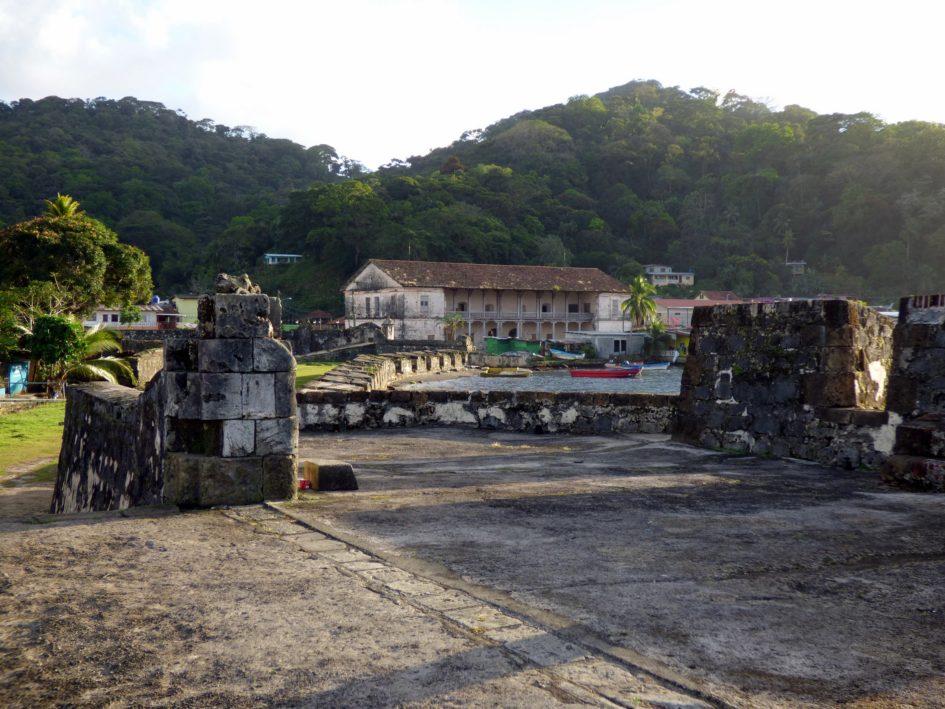Portobelo
Portobelo is a 45-minute drive from Colon on narrow and sometimes rough roads. Although the town is very run-down, there is a huge amount of history here, it being the place where all that conquistador gold was gathered before being sent to Europe.
- 1502 – Christopher Colombus named ‘Puerto Bello,’ the Beautiful Port when he stopped here on his fourth New World voyage
- Over time, the name shortened to ‘Portobelo.’
- 1585 – became clear that Nombre de Dios – then the principal Spanish port on the Panama’s Caribbean coast – was too exposed and should be relocated to Portobelo
- 1595 – Sir Francis Drake destroyed Nombre de Dios
- 1597 – San Felipe de Portobelo was officially founded
- 1668 – Buccaneer Henry Morgan squeezed one hundred thousand pesos from the Spanish authorities in exchange for not levelling the place
- 1738 – British naval commander Sir Edward Vernon made no such concession and destroyed the two fortresses
- 1751 – New, smaller forts built, since Portobelo’s commercial importance was already waning as the Spanish had rerouted their ships round Cape Horn from about 1740
- 1821 – Spanish garrison finally abandoned the town
- Today a Unesco World Heritage Site, population < 3,000
British admiral Edward (Old Grog) Vernon was immortalised in the Royal Navy’s daily rations of rum and water.
The sights in Portobelo
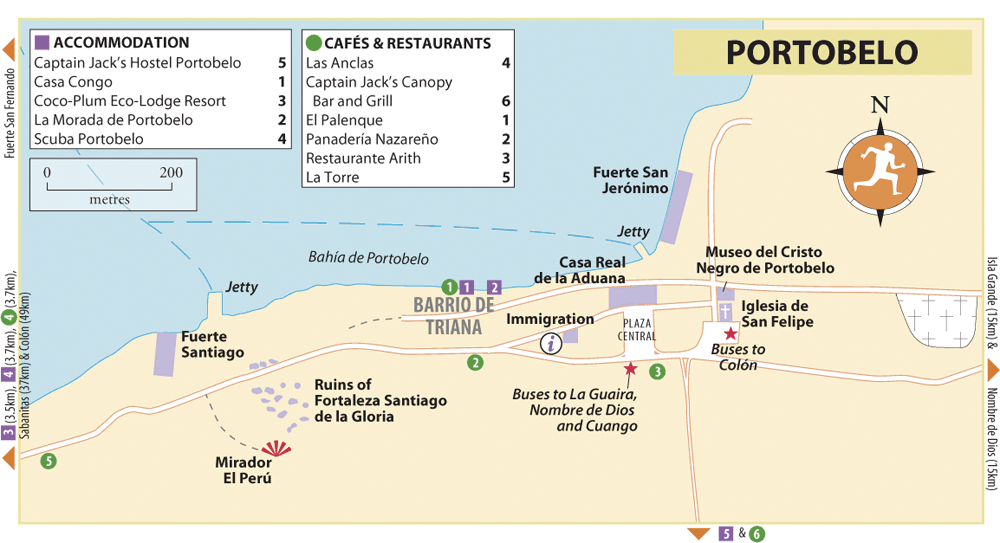
A third of the world’s gold and copious other treasures passed through the customs house in Portobelo for over a century.
Sir Francis Drake, the first Englishman to circumnavigate the globe, died of dysentery in 1956 in Portobelo and lies buried in a lead coffin at the bottom of the ocean at the entrance to the bay, near an islet which bears his name. (They can’t find it though).
Much of the outermost fortress was dismantled to build the Panama Canal and many of the larger stones were used in the construction of the Gatún Locks.
Portobelo may have the distinction of being sacked more times than any other place in the world.
Fuerte Santiago
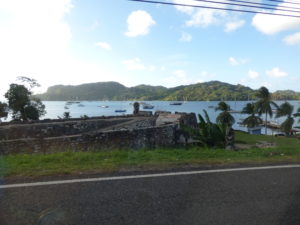
- First fort when entering the town proper from the west
- Built in the mid-eighteenth century following the destruction of the original fortifications by the British
- Some walls were 3m thick, made entirely of cut coral
The fortresses were made of coral because it was more abundant and easier to cut than the igneous rock found inland, so the Spaniards used it for most construction in Portobelo. Known “reef rock” coral is easily shaped, tough as granite yet light as pumice.
- Main entrance takes you through a vestibule protected by gun ports to the grassy parade grounds, where the ruined walls of the officers’ quarters, barracks, kitchen and artillery emplacement are visible to your left
- After a recent mudslide, some coral walls had to be replaced with cement reinforcements
- More impressive are the lower and upper batteries, their cannons pointing out across the bay
Mirador El Perú
- Steep 5-minute climb across the road from Fuerte Santiago
- Mirador on the site of a watchtower of the former Fortaleza Santiago de la Gloria, whose scarcely visible overgrown ruins are now bisected by the main road below
Fuerte San Jerónimo
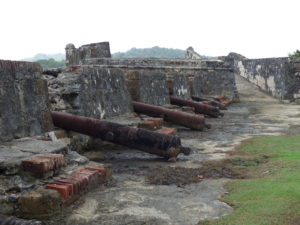
- Behind the Casa Real de la Aduana
- Largest and most impressive ruin
- Once the third-strongest fortress of Spanish America
- 18 cannon embrasures face the mouth of the bay, some exactly where the Spanish troops left them in 1821, the year Panama declared independence
- Beyond the impressive gateway of San Jerónimo are the remains of the officers’ quarters, barracks and a guardroom
- It’s worth walking along to the high battery, where you can still see the rainwater reservoir, storage rooms for gunpowder and the latrines, and get a soldier’s-eye view of the entrance of the bay
Casa Real de la Aduana
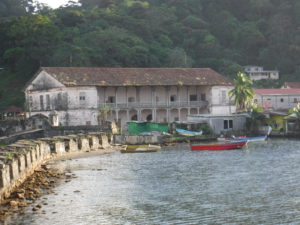
- The two-storey coral stone and brick Royal Customs House of Portobelo was built in 1630 to serve as the contaduría (counting house) for the king’s gold (replacing an earlier wooden structure)
- According to early records, no less than 233 soldiers were garrisoned in this building alone
- There was only one entrance and one exit to reduce fraud and theft and to ensure the Crown got its full royal cut of the spoils
- 1744 – destroyed by cannon fire in the Anglo-Spanish war
- 1882 – Destroyed in an earthquake
- 1997 – Restored by the Spanish who greatly upset environmentalists by using coral from a nearby reef, destroying most of the reef
- The bronze cannon at the entrance was recovered from a sunken galleon and bears a Spanish coat of arms as well as the date of manufacture (1617)
- Note the carved coral columns on the ground floor
- Now houses a small two-room museum containing models of the original forts, costumes and other exhibits including the obligatory pile of cannon balls. There is a short video in English.
Iglesia de San Felipe
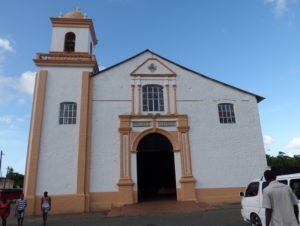
- 1606 – Construction started
- 1814 – Church completed, making it the conquistadors’ last religious building in Panama
- 1945 – Bell tower added
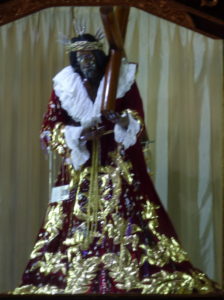
- Home of life-sized effigy of Nazareno of Portobelo, better known as the Cristo Negro or Black Christ, a dark-skinned, lifelike statue of Jesus bearing the cross that peers out from behind a glass casement
- Brought out for the annual Oct 21 Black Christ Festival
- Altar adorned with gold images depicting various emblems of the crucifixion, including nails, instruments of torture, and the dice the Roman soldiers cast for Christ’s robe
- Small wooden carvings ringing the walls depict the stages of the cross
According to legend, the statue of a dark-skinned Jesus carrying a cross arrived in Portobelo in the 17th century on a Spanish ship bound for Cartagena, Colombia. Each time the ship tried to leave, it encountered storms and had to return to port, convincing the captain to leave the statue in Portobelo. Another legend has it that in the midst of a cholera epidemic in 1821 parishioners prayed to the Cristo Negro, and the community was spared.
This is a booklet about the Black Christ that was available in Portobelo many years ago.
Museo del Cristo Negro de Portobelo
- In Iglesia de San Juan de Dios, behind Iglesia de San Felipe
- Hosts a collection of the luxurious velvet robes donated by wealthy devotees for the Christ to wear
- Changed twice a year and each used just once
- Some are over 100 years old
- One was donated by by the champion boxer Roberto “Manos de Piedra” (hands of stone) Duran
- Closed in 2012 due to lack of funding
- At the time of writing, it was uncertain when it would open
Fuerte San Fernando
- Across the bay from Fuerte Santiago you can make out what little remains of Fuerte San Fernando peeking through dense foliage
- Consists of two battlements – one near the water and one on the hill above
- Take a water-taxi ($3) from the jetty by Fuerte Santiago
- 1601 – Fuerte San Félipe and Fuerte San Diego built near the mouth of the bay
- 1739 – destroyed by Admiral Vernon. Fuerte San Fernando later built over the ruins
- American engineers dismantled much of the fort later, using its walls to create the breakwater protecting the northern end of the Panama Canal
- Though smaller than its sibling fort, the scenic spot gives a different perspective on the town
Historical streets
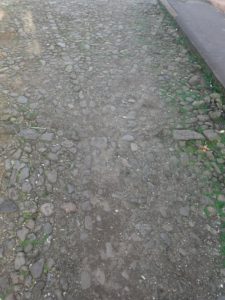
On the street between the church and the customs house you cross over some very old bridges and walk on this cobblestone mosaic, suggested to be a sundial.
